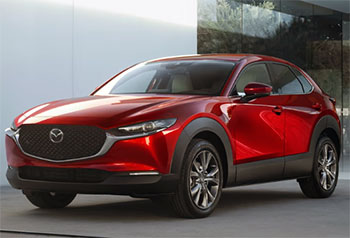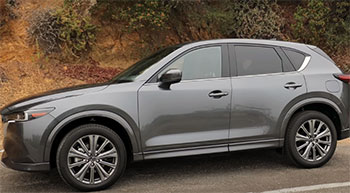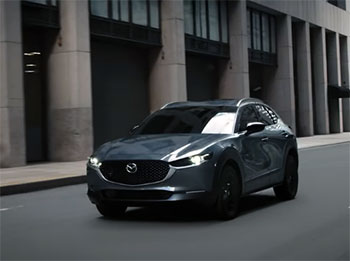I’ve always been a fan of Mazda’s sleek designs and spirited driving dynamics, so when it came time to choose between the 2025 Mazda CX-30 and CX-5, I knew I was in for a treat. Both SUVs promise premium vibes, agile handling, and impressive tech, but they cater to slightly different lifestyles.
My goal in this article is to share my firsthand experience comparing these two crossovers, breaking down their strengths and weaknesses to help you decide which one fits your needs. From city commutes to weekend getaways, let’s explore which Mazda steals the show.
Comparison Table: Mazda CX-30 vs. Mazda CX-5
| Feature | Mazda CX-30 | Mazda CX-5 |
|---|---|---|
| Starting MSRP | $26,690 | $30,265 |
| Size Classification | Subcompact SUV | Compact SUV |
| Engine Options | 2.5L 4-cylinder (191 hp); Turbo (250 hp) | 2.5L 4-cylinder (187 hp); Turbo (256 hp) |
| Fuel Economy (City/Hwy) | 26/33 MPG | 23/29 MPG |
| Cargo Space (Seats Up) | 20.2 cu. ft. | 29.1 cu. ft. |
| Passenger Volume | 94.1 cu. ft. | 104 cu. ft. |
| Towing Capacity | Not rated | Up to 2,000 lbs |
| Ground Clearance | 6.8 inches | 7.6 inches |
| Infotainment Display | 8.8-inch | 10.25-inch |
| Standard Safety Features | i-Activsense suite, Adaptive Cruise Control | i-Activsense suite, Traffic Jam Assist (upper trims) |
My Experience With the Mazda CX-30

As I slid into the driver’s seat of the 2025 Mazda CX-30, I was immediately struck by how it felt like a sporty hatchback masquerading as an SUV.
Its compact size—measuring 173 inches long and 70.7 inches wide—made it a breeze to navigate through crowded city streets.
I took it on a weekend trip through winding backroads, and the CX-30’s nimble handling had me grinning ear to ear.
The standard 2.5-liter four-cylinder engine, pumping out 191 horsepower, felt peppy enough for daily driving, but I opted for the turbocharged version (250 hp with premium fuel) for an extra kick.
It delivered smooth, responsive acceleration, especially when merging onto highways.
The interior of the CX-30 is where Mazda’s premium aspirations shine. The cabin felt upscale, with soft-touch materials and a minimalist design that rivals some luxury brands.
The 8.8-inch infotainment screen, controlled via a rotary dial, was intuitive once I got the hang of it, though I wished it was touch-sensitive while parked. Features like Apple CarPlay and Android Auto came standard, and the available 12-speaker Bose audio system turned my commute into a concert hall. Safety-wise, the i-Activsense suite, including adaptive cruise control and lane-keep assist, gave me confidence on long drives.
However, the CX-30’s subcompact size has its trade-offs. The rear seats felt snug for taller passengers, and the 20.2 cubic feet of cargo space was just enough for my weekend gear but not much more. I also noticed the ride could feel a bit firm over potholes, likely due to its torsion beam rear suspension. Still, for solo commuters or small families who prioritize agility and style, the CX-30 feels like a tailored fit.
Pros Of the Mazda CX-30
- Sporty Handling: The CX-30’s tight steering and compact dimensions make it feel like a hot hatch, perfect for zipping through urban environments or carving up twisty roads. It’s a joy to drive, with precise control that rivals pricier competitors.
- Premium Interior: The cabin’s quality is a standout, with soft-touch surfaces, available leather seats, and a clean layout. It feels more luxurious than its $26,690 starting price suggests, competing with entry-level luxury SUVs.
- Fuel Efficiency: With an EPA-estimated 26/33 MPG (city/highway), the CX-30 sips fuel more efficiently than the CX-5, saving me a few bucks at the pump during my test drives.
- Standard AWD: Mazda’s i-Activ AWD comes standard, offering confident traction in rain or light snow without sacrificing much fuel economy. It’s a rare perk in the subcompact class.
- Affordable Entry Point: Starting at $26,690, the CX-30 is about $3,500 cheaper than the CX-5, making it a budget-friendly option for younger buyers or those wanting premium features without a luxury price tag.
- Advanced Safety Features: The i-Activsense suite, including adaptive cruise control, blind-spot monitoring, and automatic emergency braking, is standard across all trims, giving peace of mind on every drive.
- Turbo Option: The available 2.5-liter turbo engine (250 hp with premium fuel) adds serious punch, making the CX-30 feel quick and responsive for performance enthusiasts like me.
Read More: My Thoughts On Acura MDX Vs. Jeep Grand Cherokee
Cons Of the Mazda CX-30
- Limited Cargo Space: With only 20.2 cubic feet behind the rear seats, the CX-30 struggles with bulky items. I could fit a couple of suitcases, but larger loads required folding the seats, which isn’t always practical.
- Cramped Rear Seats: The 36.3 inches of rear legroom felt tight for my taller friends, and getting in and out of the back wasn’t as easy as in the CX-5. It’s not ideal for frequent rear-seat passengers.
- Firm Ride: The torsion beam rear suspension makes bumps and potholes more noticeable, especially on rough city roads. I felt every thud during my drive through pothole-riddled streets.
- Non-Touch Infotainment: The 8.8-inch display relies on a rotary dial, which can be clunky when navigating menus like Spotify. I found myself taking my eyes off the road more than I’d like.
- No Towing Rating: Unlike the CX-5, the CX-30 isn’t rated for towing, limiting its utility for those who need to haul trailers or small boats.
- Smaller Fuel Tank: The 13.5-gallon fuel tank means more frequent stops at the gas station compared to the CX-5’s 15.3 gallons, which was noticeable on longer trips.
- Less Ground Clearance: At 6.8 inches, the CX-30’s ground clearance is lower than the CX-5’s 7.6 inches, making it less capable on uneven terrain or light off-roading.
My Experience With the Mazda CX-5

Switching to the 2025 Mazda CX-5 felt like stepping into a slightly more grown-up version of the CX-30.
As a compact SUV, it’s noticeably larger—180.1 inches long and 72.6 inches wide—offering a more commanding presence on the road.
I took it on a family road trip, and the extra space made a big difference.
The standard 2.5-liter engine (187 hp) was adequate, but the turbocharged option (256 hp with premium fuel) gave it the muscle needed for confident passing on highways.
The CX-5’s ride was smoother than the CX-30’s, thanks to its multi-link rear suspension, which soaked up bumps with ease.
Inside, the CX-5 felt like a step up in refinement. The 10.25-inch infotainment screen was crisp and responsive, though it still used the rotary dial system. Features like ventilated front seats and a power liftgate in higher trims added a touch of luxury, and the 29.1 cubic feet of cargo space easily swallowed my family’s luggage.
The i-Activsense safety suite was just as robust as the CX-30’s, with added Traffic Jam Assist in upper trims making stop-and-go traffic less stressful.
However, the CX-5’s larger size made it less nimble in tight spaces, and its fuel economy (23/29 MPG) was slightly worse than the CX-30’s. The higher starting price of $30,265 also gave me pause, especially for budget-conscious buyers. Still, for those needing more room and versatility, the CX-5 delivers in spades.
Pros Of the Mazda CX-5
- Spacious Interior: With 104 cubic feet of passenger volume and 39.6 inches of rear legroom, the CX-5 is a haven for families or those carrying taller passengers. My friends had no complaints about comfort.
- Generous Cargo Space: The 29.1 cubic feet behind the rear seats (59.3 with seats folded) easily handled my road trip gear, including coolers and duffel bags, with room to spare.
- Smooth Ride: The multi-link rear suspension absorbs road imperfections better than the CX-30, making long drives more comfortable, especially on uneven highways.
- Towing Capability: Rated for up to 2,000 pounds, the CX-5 can tow small trailers or boats, a feature the CX-30 lacks, which came in handy for a friend’s camping gear.
- Larger Infotainment Screen: The 10.25-inch display is sharper and more modern than the CX-30’s 8.8-inch screen, enhancing the cabin’s premium feel.
- Luxury Features: Higher trims offer ventilated seats, a heated steering wheel, and a power liftgate, making the CX-5 feel like a mini-luxury SUV without the hefty price tag.
- Traffic Jam Assist: Available in upper trims, this feature reduces fatigue in stop-and-go traffic, a lifesaver during my rush-hour commutes.
Cons Of the Mazda CX-5
- Higher Price Tag: Starting at $30,265, the CX-5 is pricier than the CX-30, which might stretch budgets for buyers seeking value without needing the extra space.
- Lower Fuel Economy: The 23/29 MPG rating is less efficient than the CX-30’s 26/33 MPG, noticeable during my week of mixed city and highway driving.
- Less Agile Handling: The CX-5’s larger size makes it less nimble than the CX-30, especially in tight parking lots or urban traffic where I felt less confident maneuvering.
- Rotary Dial Infotainment: Like the CX-30, the CX-5’s non-touch 10.25-inch screen can be frustrating to navigate, especially for quick tasks like changing playlists.
- Heavier Weight: The CX-5’s heavier build (3,700–4,000 lbs vs. the CX-30’s 3,300–3,600 lbs) dulls acceleration slightly, even with the turbo engine.
- Limited Off-Road Capability: Despite 7.6 inches of ground clearance, the CX-5 isn’t built for serious off-roading, limiting its appeal for adventure seekers.
- Dated Interior Design: While upscale, the CX-5’s cabin layout feels less modern compared to newer rivals with sleeker, screen-heavy dashboards.
Digging Deeper: Performance and Driving Dynamics

Both the CX-30 and CX-5 share Mazda’s commitment to driving fun, a rarity in the SUV world. The CX-30’s smaller footprint and lighter weight (around 3,300 pounds for the base model) give it a sportier edge.
During my test drives, I felt like I was driving a Mazda3 hatchback with a higher ride height.
The G-Vectoring Control Plus system, standard on both, subtly adjusts engine torque to improve cornering stability, making the CX-30 feel planted on winding roads.
The turbocharged engine, available on higher trims, transforms it into a pocket rocket, hitting 60 mph in about 6.4 seconds based on industry tests.
The CX-5, while still engaging, leans more toward refinement than outright sportiness. Its heavier frame (around 3,700 pounds for the base model) and longer wheelbase (106.2 inches vs. the CX-30’s 104.4) provide a more stable, composed ride, especially at highway speeds.
The turbocharged CX-5 is slightly quicker, reaching 60 mph in about 6.2 seconds, but the difference is subtle in real-world driving. Both SUVs come with standard i-Activ AWD, which seamlessly distributes power to maintain grip in slippery conditions. I tested this on a rainy day, and both handled wet roads with confidence, though the CX-5’s extra weight gave it a slight edge in stability.
Fuel economy is where the CX-30 pulls ahead. Its 26/33 MPG (city/highway) with the standard engine beats the CX-5’s 23/29 MPG, a difference I noticed during a week of commuting. However, the CX-5’s larger 15.3-gallon fuel tank offers a longer range, which was a plus on my road trip.
For performance enthusiasts, both SUVs offer turbo engines, but the CX-30’s lighter chassis makes it feel more agile, while the CX-5’s extra power suits those who prioritize straight-line speed.
Interior Comfort and Technology
Inside, both SUVs showcase Mazda’s knack for blending premium materials with practical design. The CX-30’s cabin feels intimate, with a driver-focused cockpit and high-quality finishes like available leather and aluminum trim. I loved the minimalist dashboard, but the 8.8-inch infotainment screen felt small compared to rivals’ larger displays.
The rotary dial controller, while precise, was less intuitive than a touchscreen for quick tasks. Still, the standard Apple CarPlay and Android Auto integration worked flawlessly, and the optional 12-speaker Bose system delivered crisp sound.
The CX-5’s interior feels more spacious and refined, especially in higher trims like the Signature, which offers cocoa Nappa leather and ventilated seats. The 10.25-inch screen is a step up, with vibrant graphics and faster response times. However, the rotary dial system remains a pain point, especially when navigating apps like Spotify.
The CX-5’s 104 cubic feet of passenger volume and 39.6 inches of rear legroom made it a favorite for my passengers, who appreciated the extra space and easier access. Cargo-wise, the CX-5’s 29.1 cubic feet behind the rear seats dwarfed the CX-30’s 20.2 cubic feet, making it the go-to for family outings or bulkier loads.
Both SUVs offer heated seats, dual-zone climate control, and available head-up displays, but the CX-5 edges out with extras like a power liftgate and Traffic Jam Assist in upper trims. For tech-savvy buyers, both support wireless Apple CarPlay and Android Auto in mid-level trims, plus wireless charging. However, I found the CX-30’s gauge cluster, with its 7-inch digital display, slightly more modern than the CX-5’s analog-heavy setup.
Safety and Reliability
Mazda’s commitment to safety is evident in both SUVs, with the i-Activsense suite standard across all trims. Features like adaptive cruise control, blind-spot monitoring, lane-keep assist, and automatic emergency braking worked seamlessly in my tests, earning both models top marks from the IIHS and NHTSA. The CX-30’s Driver Attention Alert, available on higher trims, was a nice touch for long drives, while the CX-5’s Traffic Jam Assist made city commutes less taxing.
Reliability-wise, both SUVs have strong reputations. Consumer feedback highlights Mazda’s durability, with low maintenance costs compared to rivals. However, some CX-30 owners have reported minor issues with the turbo engine or infotainment glitches, though my test vehicles were flawless. The CX-5, with a longer market presence, has more data backing its dependability, but both feel built to last with proper care.
Lifestyle Fit: Who Are These SUVs For?
The CX-30 is a perfect match for urban dwellers, young professionals, or small families who value agility and style. Its compact size makes parking a breeze, and its fuel efficiency suits daily commutes. I found it ideal for solo trips or couples with minimal cargo needs, but its tight rear seats and limited cargo space make it less practical for growing families or frequent haulers.
The CX-5, on the other hand, is the family-friendly choice. Its spacious interior, generous cargo area, and towing capability cater to those who need versatility for school runs, road trips, or outdoor adventures. I appreciated its smoother ride and extra features, but its larger footprint and higher price might deter budget-conscious buyers or those in tight urban spaces.
Cost and Value Proposition
Price is a key differentiator. The CX-30’s $26,690 starting MSRP makes it an attractive entry point, especially with standard AWD and safety features. Its lower running costs, thanks to better fuel economy, add to its value for cost-conscious buyers. The CX-5, starting at $30,265, offers more space and features but at a premium. Its stronger resale value, based on industry trends, makes it a better long-term investment for families or those planning to keep their SUV for years.
Both SUVs offer a range of trims, from budget-friendly base models to near-luxury options like the CX-30 Premium Plus or CX-5 Signature. Leasing is an option for those wanting flexibility, with the CX-30 being the cheaper lease due to its lower MSRP. For buyers prioritizing upfront savings, the CX-30 wins; for those needing space and versatility, the CX-5’s extra features justify the cost.
Read More: My Thoughts On Ford Escape Vs. Mazda CX-5
Frequently Asked Questions (FAQ)
The CX-30 is a subcompact SUV, smaller and more agile, with better fuel economy (26/33 MPG) and a lower starting price ($26,690). The CX-5 is a compact SUV with more cargo space (29.1 cu. ft.), rear legroom (39.6 inches), and towing capacity (2,000 lbs), but it’s pricier ($30,265) and less fuel-efficient (23/29 MPG).
The CX-30 has limited cargo space (20.2 cu. ft.), cramped rear seats (36.3 inches legroom), a firm ride over bumps, and a non-touch infotainment system. It’s not rated for towing and has a smaller fuel tank (13.5 gallons).
The CX-30’s popularity stems from its sporty handling, premium interior, standard AWD, and affordable price. Its stylish design and fuel efficiency appeal to urban drivers and young buyers seeking a near-luxury experience.
No, the CX-5 is not being phased out. Mazda continues to update it for 2025, maintaining its role as a core compact SUV alongside newer models like the CX-50 and CX-70.
Conclusion: For Mazda CX-30 and CX-5
You can’t go wrong with either the Mazda CX-30 or CX-5—both deliver Mazda’s signature blend of style, performance, and value. If you’re an urban driver or young professional craving agility and efficiency, the CX-30’s sporty vibe and lower price make it a fantastic choice. For families or those needing more space and versatility, the CX-5’s roomy interior and towing capability are hard to beat. Test-drive both to feel their distinct personalities, and you’ll find the perfect Mazda for your lifestyle.

